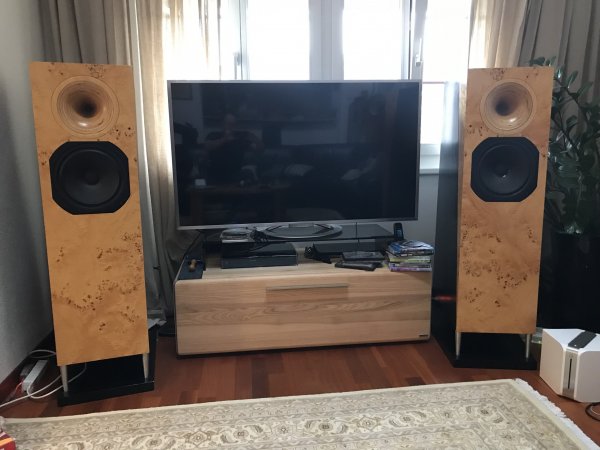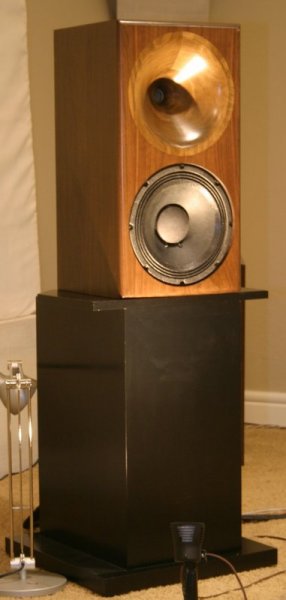What are the pros & cons of high-efficiency horns?
- Thread starter manisandher
- Start date
You are using an out of date browser. It may not display this or other websites correctly.
You should upgrade or use an alternative browser.
You should upgrade or use an alternative browser.
Of course they can be simple if you don’t care all that much about linearizing impedance or frequency response. I have experienced situations where the removal of one of these networks completely improved the sound despite measuring worse. Did you start simpler and advance to this complexity?
This depends on the transparency of the network you are adding. If it is transparent enough and doing its job, you get best of both worlds. To do that you need experience with components. I have russian micas, even vacuum capacitors as bypass caps on this network. I can not design a crossover like this. It has been designed by two German engineers who specialize in filter design and are both actively work with horn speakers.
Ah so you are doing the Geddes foam thing in the horn as well?
Yes, I was inspired by Geddes however my trials on my 200hz tractrix horn were negative. The only good came out of it in jmlc 1400hz horn and without much of it and with 30ppi. It is something small to add but it this is a cumulative experience. Everything has to work together in harmony.
My family horn system
Nice what are they?? That a tractrix?? Up on stands it that a midrange/midwoofer with an internal subwoofer?
Rob
what compressing driver do these use?
Odeon La Boheme. The horn is either a Tractrix or Spherical, not sure which. Not on stands , it is a back loaded TQWT so the whole bottom is open and the gap to the base sets the amount and speed of the bass. The tweeter is a Beyma CP350Ti 1 inch compression driver and the mid/bass is an old but very good Focal paper cone (famous in France for Onken box designs). Sensitivity around 97db.Nice what are they?? That a tractrix?? Up on stands it that a midrange/midwoofer with an internal subwoofer?
Rob
The driver is a Beyma CP755Ti.
Beymas are excellent in my experience. I haven't used any of the large-format Beymas yet, but the CP-385Nd is very nice in a small-format driver.
Ime it's a good idea for the driver's exit angle to match the horn's entry angle (or at least come close). Your statement that the CP-755Ti on the 18Sound XT1464 sounds "very uncolored" makes me think you either paid attention to this, or the audio gods were smiling on you. (Not that I take every DIYer's endorsement of his handiwork at face value, but you have credibility in my opinion.)
By the way, lovely little speakers in your family room system... Odeons, I presume? [edit: I was typing while you were replying to Rob.] I'm working with wooden horns now as well:
Attachments
Last edited:
Wonderful sounding Beyma CP350Ti. It was also used in the very exotic Jadis Eurythmie II horn speaker from the late 90s.what compressing driver do these use?
Beautiful little speaker. You are using the CP385Nd on that one? Maybe you can see on the floor of my upstairs system photos a small pair of horns on each side the speakers. That is a pair of CP350TIs I picked up used (rare and not so cheap) mates to some small 18 Sound XT120 elliptical horns. I will eventually see if they outperform the CP755Tis crossing around 1500hz. The CP350Ti has very low measured distortion and basically no breakup seen despite being a pure Ti diaphragm. Maybe a TAD is better but then it must be REALLY something special.Beymas are excellent in my experience. I haven't used any of the large-format Beymas yet, but the CP-385Nd is very nice in a small-format driver.
Ime it's a good idea for the driver's exit angle to match the horn's entry angle (or at least come close). Your statement that the CP-755Ti on the 18Sound XT1464 sounds "very uncolored" makes me think you either paid attention to this, or the audio gods were smiling on you. (Not that I take every DIYer's endorsement of his handiwork at face value, but you have credibility in my opinion.)
By the way, lovely little speakers in your family room system... Odeons, I presume? [edit: I was typing while you were replying to Rob.] I'm working with wooden horns now as well:
ive heard the Jadis, without a doubt an excellent sounding speaker.Wonderful sounding Beyma CP350Ti. It was also used in the very exotic Jadis Eurythmie II horn speaker from the late 90s.
I am tempted to get an Iwata 600 and JMLC 600 from Poland to see how they compare with the 18 Sound ESS Elliptical constant directivity horns I am using now. These sound very uncolored.
View attachment 57923View attachment 57924
Iwata will have broad horizontal dispersion a lot like a regular speaker, IME JMLC gives you the cleanest and most 3-D presentation, the downside is it's large diameter so maybe not the best choice for all applications. For my speaker it works well. With Iwata you will lose some of the awesome, immersive 3-D feel of JMLC imo...
Using a wideband cone driver liker I do as well as AER, also AG and maybe Odeon for mids, can simplify the crossover requirements vs a CD, and imo a CD isn't necessary for home use at normal SPLs. While I admire complex 4+ way systems like Kodomo and others, it's certainly more complicated. I can get away with using a single cap for both my mid and tweeter, and I think AG has models that use no xo at all on their mid horn, or they used to. I don't think that's a great idea as you get excessive excursion.
Beautiful little speaker.
Thank you very much. It's called the Gina, and we showed it at T.H.E. Show a few months ago. Ron Resnik and Steve Williams came by, and each took some very good photos (and posted some comments):
https://www.whatsbestforum.com/threads/audiokinesis-duke-lejeune-james-romeyn-t-h-e-show-2019.28266/
https://www.whatsbestforum.com/threads/the-show-2019-steves-photos.28246/page-6#post-580321
You are using the CP385Nd on that one?
Actually the Gina uses the Radian 475PB-Be (1" throat with a big ferrite motor, Beryllium diaphragm). I used the CP385Nd in some of my earlier designs, including the one that was my biggest commercial success, which had to be discontinued because I could no longer get the 10" TAD woofer it used.
Maybe you can see on the floor of my upstairs system photos a small pair of horns on each side the speakers. That is a pair of CP350TIs I picked up used (rare and not so cheap) mates to some small 18 Sound XT120 elliptical horns. I will eventually see if they outperform the CP755Tis crossing around 1500hz. The CP350Ti has very low measured distortion and basically no breakup seen despite being a pure Ti diaphragm. Maybe a TAD is better but then it must be REALLY something special.
Yes I saw those, thought they were SEOS horns from the angle of the photo, but now I can see that they're the 18Sounds. I measured the XT120 and found that its directivity narrowed considerably at high frequencies, and at the time I didn't have a work-around for that. Nowadays I'd use a rear-firing tweeter tailored to fill in the missing off-axis energy.
I like the Radians better than the TAD compression drivers. Here is one of the reasons why: The TADs have a very long internal "snout" going from the phase plug to the exit. Remember that, in effect, the horn starts at the phase plug, so the very beginning of the horn is actually inside the compression driver. On the TADs, the "snout" is long enough that it effectively sets the radiation pattern angle at short wavelengths, and its angle is very narrow, so the highs beam badly unless you use a diffraction horn, which imo just trades off one problem for another (namely, diffraction).
On the other hand drivers like the Beymas and Radians and most modern compression drivers have a much shorter internal "snout" which allows the horn itself to dominate the radiation pattern control at high frequencies. So my little Gina speakers, which use a "constant directivity" oblate spheroid profile (shout-out to Earl Geddes), hold up pretty well off-axis in the top octave. The tradeoff is, less on-axis efficiency... not an issue for the 91 dB ballpark Ginas, but potentially an issue when the day comes that I start chasing 100 dB.
Last edited:
(...) It was also used in the very exotic Jadis Eurythmie II horn speaker from the late 90s.
It was one the speakers I considered for the Lamm ML3. Although rare we can get them in Europe
around 20 ~30 Keuros. What is the general opinion about it? It got a very positive review in Stereophile in the 90's, https://www.stereophile.com/content/jadis-eurythmie-ii-loudspeaker the hifi press did not ignore horn speakers!
ive heard the Jadis, without a doubt an excellent sounding speaker.
Considering the AvantGarde range of models as a scale, where you would you situate it?
It was one the speakers I considered for the Lamm ML3. Although rare we can get them in Europe
around 20 ~30 Keuros. What is the general opinion about it? It got a very positive review in Stereophile in the 90's, https://www.stereophile.com/content/jadis-eurythmie-ii-loudspeaker the hifi press did not ignore horn speakers!
Did you consider a pair of Trios with the horn subs? Would think they’ll work with your Lamms and they have decent resale / support if the latter is important.
Considering the AvantGarde range of models as a scale, where you would you situate it?
I was really blown away when I heard it. I would put it in the middle of an Avantgarde Duo Omega and a classic Tannoy 15". You get the top level resolution of the Avantgarde but the great bass of the Tannoy. The speaker bests every speaker I've heard except for the Tannoy Autograph Professionals. Full Jadis system but I don't remember the actual model of amps.
Although I love my current speakers, now that I have more room I would buy a pair in a heartbeat if they came up.
Did you consider a pair of Trios with the horn subs? Would think they’ll work with your Lamms and they have decent resale / support if the latter is important.
Trios need an wide room, even the compact version. Otherwise I would have tried them. But, in general, I have not seen a great enthusiasm for the Avantgarde / Lamm pairing online.
BTW, nothing of this size has decent resale value ...
(...) Although I love my current speakers, now that I have more room I would buy a pair in a heartbeat if they came up.
Fortunately Greece is far away from me ...
https://www.chameleon-audio.com/en/second-hand/category/39-speakers

Interestingly, it appears that Avantgarde is using the Beyma CP380m as the tweeter in the Duo series and Trio series. This is the successor to the CP350TI and appears from specs to be the same motor but with a plastic dome instead of a Ti dome.Did you consider a pair of Trios with the horn subs? Would think they’ll work with your Lamms and they have decent resale / support if the latter is important.
Interestingly, it appears that Avantgarde is using the Beyma CP380m as the tweeter in the Duo series and Trio series. This is the successor to the CP350TI and appears from specs to be the same motor but with a plastic dome instead of a Ti dome.
Any idea what they use in the mid bass horn?
Similar threads
- Replies
- 58
- Views
- 7K
- Replies
- 64
- Views
- 7K
- Replies
- 2
- Views
- 1K
- Replies
- 9
- Views
- 5K





